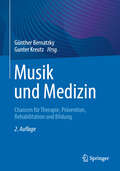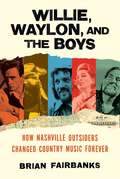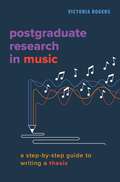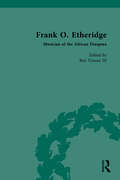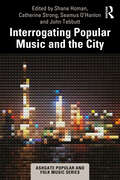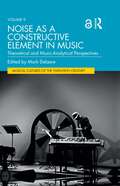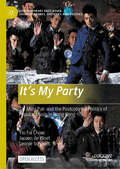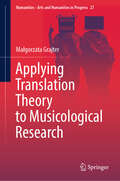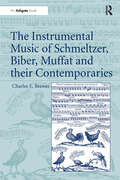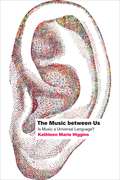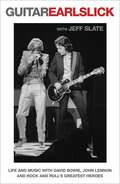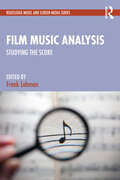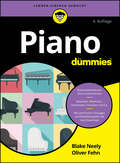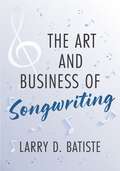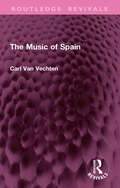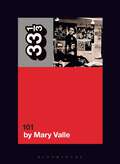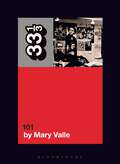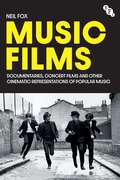- Table View
- List View
Musik und Medizin: Chancen für Therapie, Prävention, Rehabilitation und Bildung
by Günther Bernatzky Gunter KreutzDieses Buch beleuchtet die Wirkungen von Musik auf Gesundheit, Wohlbefinden und Lebensqualität aus der Sicht interdisziplinärer, musikwissenschaftlicher und medizinischer Forschung. Hochrangige Expert*innen aus vielfältigen Fachgebieten stellen die wissenschaftlichen Grundlagen für medizinische, therapeutische, pädagogische und andere Anwendung vor. Inhaltlich spannt es den Bogen von den psychophysiologischen Grundlagen emotionaler Wirkungen des Musikhörens bis hin zu musikmedizinischen und -therapeutischen Interventionen. Musik erweist sich vielfach als äußerst wirksame, nahezu nebenwirkungsfreie und vergleichsweise kostengünstige unterstützende Strategie für Prävention, Therapie und Rehabilitation in vielen medizinischen Fachbereichen.Ein breites Spektrum musikalischer Aktivitäten einschließlich Musikhören, Laienmusizieren, Chorsingen, Tanzen und verschiedene Formen musiktherapeutischer Strategien steht den Erfordernissen unterschiedlicher Zielgruppen, individuellen Unterschieden, Vorlieben und kulturellen Hintergründen gegenüber. Die Neuauflage wurde aktualisiert und mit Inhalten zu COVID 19 und einer neuen Sektion zu gesundheitlichen Belastungen durch Musik erweitert.Ärzt*innen und medizinisches Personal in Sozial- und Pflegeberufen erhalten profunde Informationen über Chancen und Grenzen musikbezogener Angebote. Die Kapitel eignen sich ebenso als Einstiege für Wissenschaftler*innen zahlreicher Fachrichtungen aus Sozial-, Natur- und Geisteswissenschaft.
Willie, Waylon, and the Boys: How Nashville Outsiders Changed Country Music Forever
by Brian FairbanksThe tragic and inspiring story of the leaders of Outlaw country and their influence on today&’s Alt-County and Americana superstars, tracing a path from Waylon Jennings&’ survival on the Day the Music Died through to the Highwaymen and on to the current creative and commercial explosion of Chris Stapleton, Brandi Carlile, Zach Bryan, Jason Isbell, and the Highwomen. On February 2, 1959, Waylon Jennings, bassist for his best friend, the rock star Buddy Holly, gave up his seat on a charter flight. Jennings joked that he hoped the plane, leaving without him, would crash. When it did, killing all aboard, on "the Day the Music Died," he was devastated and never fully recovered. Jennings switched to playing country, creating the Outlaw movement and later forming the Highwaymen supergroup, the first in country music, with Johnny Cash, Willie Nelson, and Kris Kristofferson. The foursome battled addiction, record companies, ex-wives, violent fans, and the I.R.S. and D.E.A., en route to unprecedented mainstream success. Today, their acolytes Kacey Musgraves, Ryan Bingham, Sturgill Simpson, and Taylor Swift outsell all challengers, and country is the most popular of all genres. In this fascinating new book, Brian Fairbanks draws a line from Buddy Holly through the Outlaw stars of the 60s and 70s, all the way to the country headliners and more diverse, up-and-coming Nashville rebels of today, bringing the reader deep into the worlds of not only Cash, Nelson, Kristofferson, and Jennings but artists like Chris Stapleton, Simpson, Bingham, and Isbell, stadium-filling masters whose stories have not been told in book form, as well as new, diverse artists like the Highwomen, Brittney Spencer, and Allison Russell. Thought-provoking and meticulously researched, Willie, Waylon, and the Boys ultimately shows how a twenty-one-year-old bass-playing plane crash survivor helped changed the course of American music.
Postgraduate Research in Music: A Step-by-Step Guide to Writing a Thesis
by Victoria RogersPostgraduate Research in Music: A Step-by-Step Guide to Writing a Thesis is an essential text for music students who are undertaking postgraduate research. Unique in its approach and scope, this is a "how to" book, a practical guide that sets out, step-by-step, how to write a thesis. It discusses all key aspects of the research process in the order in which they are encountered, from the initial stages of a research project to completion of a thesis. It also offers a music-specific focus, with explanations and examples that are immediately relevant for all music research and which take into account the special characteristics of music as a discipline. At the same time, the book provides a useful teaching framework for lecturers. All key concepts are illustrated with music-relevant examples. Exercises, and in some chapters class seminar topics as well, are included to reinforce the concepts being discussed. Reading lists are appended at the end of most chapters, enabling students to explore topics in greater depth. Valuable supplementary information, such as referencing examples, is provided in the appendices. Postgraduate Research in Music is based on the premise that there are certain principles that underpin good scholarship, regardless of the area in which the research is conducted. In distilling and discussing these principles, this book speaks to all scholars working within the discipline of music.
Postgraduate Research in Music: A Step-by-Step Guide to Writing a Thesis
by Victoria RogersPostgraduate Research in Music: A Step-by-Step Guide to Writing a Thesis is an essential text for music students who are undertaking postgraduate research. Unique in its approach and scope, this is a "how to" book, a practical guide that sets out, step-by-step, how to write a thesis. It discusses all key aspects of the research process in the order in which they are encountered, from the initial stages of a research project to completion of a thesis. It also offers a music-specific focus, with explanations and examples that are immediately relevant for all music research and which take into account the special characteristics of music as a discipline. At the same time, the book provides a useful teaching framework for lecturers. All key concepts are illustrated with music-relevant examples. Exercises, and in some chapters class seminar topics as well, are included to reinforce the concepts being discussed. Reading lists are appended at the end of most chapters, enabling students to explore topics in greater depth. Valuable supplementary information, such as referencing examples, is provided in the appendices. Postgraduate Research in Music is based on the premise that there are certain principles that underpin good scholarship, regardless of the area in which the research is conducted. In distilling and discussing these principles, this book speaks to all scholars working within the discipline of music.
Frank O. Etheridge: Musician of the African Diaspora
by Ben Vinson IIIThis is a book by and about Frank O. Etheridge, an African-American musician from an age of cultural explosion. The decade after World War II saw the coming-of-age of marginalized cultures, and in North America a new voice emerged among peoples of African descent. Etheridge performed in a period when some of the greatest cultural producers of the African-American heritage assumed center-stage. From Shanghai to Singapore; from India to Africa and beyond, Frank Etheridge left us a detailed record of his travels in his unpublished manuscript. The book contains his views, insights, and international itinerary during the 1920s. His book is an important volume in the annals of African-American history, not just for its content, but for what it means and symbolizes. Its readers will journey with him, see through his eyes, understand race and racial prejudice as lived in ordinary skin, and sample culture. Some of Etheridge’s reflections and personal biases will seem like unpleasant contradictions from the way we think about racial prejudice today. However, these jarring moments of dissonance are rich learning opportunities that will connect us to his times, while unraveling a greater understanding of ourselves in our current moment. This manuscript, published for the first time, will be accompanied by editorial commentary written by Professor Ben Vinson III, and will be of great interest to students and scholars of African American history.
Frank O. Etheridge: Musician of the African Diaspora
by Ben Vinson IIIThis is a book by and about Frank O. Etheridge, an African-American musician from an age of cultural explosion. The decade after World War II saw the coming-of-age of marginalized cultures, and in North America a new voice emerged among peoples of African descent. Etheridge performed in a period when some of the greatest cultural producers of the African-American heritage assumed center-stage. From Shanghai to Singapore; from India to Africa and beyond, Frank Etheridge left us a detailed record of his travels in his unpublished manuscript. The book contains his views, insights, and international itinerary during the 1920s. His book is an important volume in the annals of African-American history, not just for its content, but for what it means and symbolizes. Its readers will journey with him, see through his eyes, understand race and racial prejudice as lived in ordinary skin, and sample culture. Some of Etheridge’s reflections and personal biases will seem like unpleasant contradictions from the way we think about racial prejudice today. However, these jarring moments of dissonance are rich learning opportunities that will connect us to his times, while unraveling a greater understanding of ourselves in our current moment. This manuscript, published for the first time, will be accompanied by editorial commentary written by Professor Ben Vinson III, and will be of great interest to students and scholars of African American history.
Interrogating Popular Music and the City (ISSN)
How does popular music influence the culture and reputation of a city, and what does a city do to popular music? Interrogating Popular Music and the City examines the ways in which urban environments and music cultures intersect in various locales around the globe. Music and cities have been partners in an often clumsy, sometimes accidental but always exciting dance. Heritage and immigration, noise and art, policy and politics are some of the topics that are addressed in this critical examination of relationships between cities and music. The book draws upon an international array of researchers, encompassing hip hop in Beijing; the city favelas of Brazil; from Melbourne bars to European parliaments; to heritage and tourism debates in Salzburg and Manchester. In doing so, it interrogates the different agendas of audiences, musicians and policy-makers in distinct urban settings.
Interrogating Popular Music and the City (ISSN)
by Catherine Strong Shane Homan Seamus O'Hanlon John TebbuttHow does popular music influence the culture and reputation of a city, and what does a city do to popular music? Interrogating Popular Music and the City examines the ways in which urban environments and music cultures intersect in various locales around the globe. Music and cities have been partners in an often clumsy, sometimes accidental but always exciting dance. Heritage and immigration, noise and art, policy and politics are some of the topics that are addressed in this critical examination of relationships between cities and music. The book draws upon an international array of researchers, encompassing hip hop in Beijing; the city favelas of Brazil; from Melbourne bars to European parliaments; to heritage and tourism debates in Salzburg and Manchester. In doing so, it interrogates the different agendas of audiences, musicians and policy-makers in distinct urban settings.
Noise as a Constructive Element in Music: Theoretical and Music-Analytical Perspectives (Musical Cultures of the Twentieth Century)
by Mark DelaereMusic and noise seem to be mutually exclusive. Music is generally considered as an ordered arrangement of sounds pleasing to the ear and noise as its opposite: chaotic, ugly, aggressive, sometimes even deafening. When presented in a musical context, noise can thus act as a tool to express resistance to predominant cultural values, to society or to socioeconomic structures (including those of the music industry). The oppositional stance confirms current notions of noise as something which is destructive, a belief not only cherished by hard-core rock bands but also shared by engineers and companies developing devices to suppress or reduce noise in our daily environment.In contrast to the common opinions on noise just described, this volume seeks to explore the constructive potential of noise in contemporary musical practices. Rather than viewing noise as a ‘defect’, this volume aims at studying its aesthetic and cultural potential.Within the noise music study field, most recent publications focus on subgenres such as psychedelic post-rock, industrial, hard-core punk, trash or rave, as they developed from rock and popular music. This book includes work on avant-garde music developed in the domain of classical music as well. In addition to already well-established (social) historical and aesthetical perspectives on noise and noise music, this volume offers contributions by music analysts.
It’s My Party: Tat Ming Pair and the Postcolonial Politics of Popular Music in Hong Kong (Contemporary East Asian Visual Cultures, Societies and Politics)
by Jeroen de Kloet Yiu Fai Chow Leonie SchmidtThis book is unique in focusing on just one band from one city – but the story of Tat Ming Pair, in so many ways, is the story of Hong Kong's recent decades, from the Handover to the Umbrella Movement to 2019's standoff. A comprehensive, theoretically informed study of the sonic history and present of Hong Kong through the prism of Tat Ming Pair, this book will be of interest to cultural studies scholars, scholars of Hong Kong, and those who study the arts in East Asia.This is an open access book.
Applying Translation Theory to Musicological Research (Numanities - Arts and Humanities in Progress #27)
by Małgorzata GrajterThis monograph lays the foundation for new methodologies of research between music and translation. It is the first such holistic attempt—from the perspective of a musicologist—based on the adaptation of translation theories. Until now, these fields have remained underexplored together. Only recently have the tools developed by translation theory permeated into musical scholarship. Such tools should prove as a promising alternative to those offered by classic musicological studies, particularly in reference to musical arrangement, pop music covers and performance. Theoretical discussion on topics are supported by case studies. This text appeals to musicologists and musicians as well as experts in the field of translation theory who are interested in expanding their field of inquiry.
The Instrumental Music of Schmeltzer, Biber, Muffat and their Contemporaries
by Charles E. BrewerBased on primary sources, many of which have never been published or examined in detail, this book examines the music of the late seventeenth-century composers, Biber, Schmeltzer and Muffat, and the compositions preserved in the extensive Moravian archives in Kromeriz. These works have never before been fully examined in the cultural and conceptual contexts of their time. Charles E. Brewer sets these composers and their music within a framework that first examines the basic Baroque concepts of instrumental style, and then provides a context for the specific works. The dances of Schmeltzer, for example, functioned both as incidental music in Viennese operas and as music for elaborate court pantomimes and balls. These same cultural practices also account for some of Biber's most programmatic music, which accompanied similar entertainments in Kromeriz and Salzburg. The many sonatas by these composers have also been misunderstood by not being placed in a context where it was normal to be entertained in church and edified in court. Many of the works discussed here remain unpublished but have, in recent years, been recorded. This book enhances our understanding and appreciation of these recordings by providing an analysis of the context in which the works were first performed.
The Music between Us: Is Music a Universal Language?
by Kathleen Marie HigginsFrom our first social bonding as infants to the funeral rites that mark our passing, music plays an important role in our lives, bringing us closer to one another. In The Music between Us, philosopher Kathleen Marie Higgins investigates this role, examining the features of human perception that enable music’s uncanny ability to provoke, despite its myriad forms across continents and throughout centuries, the sense of a shared human experience. Drawing on disciplines such as philosophy, psychology, musicology, linguistics, and anthropology, Higgins’s richly researched study showcases the ways music is used in rituals, education, work, healing, and as a source of security and—perhaps most importantly—joy. By participating so integrally in such meaningful facets of society, Higgins argues, music situates itself as one of the most fundamental bridges between people, a truly cross-cultural form of communication that can create solidarity across political divides. Moving beyond the well-worn takes on music’s universality, The Music between Us provides a new understanding of what it means to be musical and, in turn, human.
Guitar: A rock 'n' roll tell-all autobiography from David Bowie's sideman
by Jeff Slate Earl SlickRead this rollicking rock 'n' roll memoir of the last 50 years of rock history, from David Bowie's longest serving lead guitarist and legendary sideman, Earl Slick. He's played with everyone from John Lennon to the New York Dolls – and he's got the stories to prove it.----‘Earl is a legendary guitar star. His playing is earth, timeless and never less than stellar’ DAVID BOWIE ‘You play mean ass blues for a skinny ass white boy’ BUDDY GUY ‘Had a good night out did we . . .?’ JOHN LENNON Earl Slick was barely out of his teens when David Bowie hired him to play guitar on the ground-breaking 1974 Diamond Dogs tour. It marked the beginning of a relationship that would endure through thick and thin for the next forty years. Gracing classic albums like Young Americans, Station to Station and the 2013 comeback, The Next Day, Slick played on the tour that followed Bowie’s smash hit Let’s Dance album and was at his side for the epic Glastonbury show in 2000. But it wasn’t just Bowie. The young guitarist was in John Lennon’s band at the time of the former Beatle’s tragic murder. Other collaborations read like a roll call of rock ‘n’ roll royalty including Mick Jagger, The Cure, George Harrison, Ringo Starr, Joe Cocker, Buddy Guy, Ian Hunter, David Coverdale and Eric Clapton. And in the ‘80s he became an MTV star in his own right with the success of Phantom, Rocker and Slick. Through it all he lived the rock ‘n’ roll life to the hilt. Until it nearly killed him. One of rock’s great sidemen, Earl Slick was in the room when music history was made. Guitar takes us there, shining a light on superstars like Bowie and Lennon, while recounting the extraordinary story of the boy from New York City who became a real-life Johnny B. Goode.
Film Music Analysis: Studying the Score (Routledge Music and Screen Media Series)
Since the establishment of film music studies, there has been a steady growth of serious analytical work on the film music repertoire. Film Music Analysis: Studying the Score offers the first collection of essays dedicated to the close investigation of musical structure and meaning in film music. Showcasing scholarship from a diverse and distinguished group of music theorists and musicologists, this book presents the many ways to inspect the inner workings of film music in a manner that is exciting and accessible to anyone curious about this music, regardless of their background in film or music theory.Each chapter takes as its focus one music-theoretical parameter and explores how that concept can be used to analyze and interpret film music. Covering theoretical concepts that range from familiar categories such as leitmotif and pitch structure to more cutting-edge ideas such as timbral associativity, topic theory, and metrical states, the book provides a toolkit with which to explore this captivatingly varied repertoire. With example analyses drawn from classic and contemporary films, Film Music Analysis: Studying the Score is a valuable teaching tool and an indispensable addition to the library of any lover of film and music.
Film Music Analysis: Studying the Score (Routledge Music and Screen Media Series)
by Frank LehmanSince the establishment of film music studies, there has been a steady growth of serious analytical work on the film music repertoire. Film Music Analysis: Studying the Score offers the first collection of essays dedicated to the close investigation of musical structure and meaning in film music. Showcasing scholarship from a diverse and distinguished group of music theorists and musicologists, this book presents the many ways to inspect the inner workings of film music in a manner that is exciting and accessible to anyone curious about this music, regardless of their background in film or music theory.Each chapter takes as its focus one music-theoretical parameter and explores how that concept can be used to analyze and interpret film music. Covering theoretical concepts that range from familiar categories such as leitmotif and pitch structure to more cutting-edge ideas such as timbral associativity, topic theory, and metrical states, the book provides a toolkit with which to explore this captivatingly varied repertoire. With example analyses drawn from classic and contemporary films, Film Music Analysis: Studying the Score is a valuable teaching tool and an indispensable addition to the library of any lover of film and music.
Piano für Dummies (Für Dummies)
by Blake Neely Oliver FehnTasten Sie sich an das Pianospielen heran Kaum ein Instrument fasziniert so wie das Piano, sei es als Klavier, Keyboard oder Orgel. Blake Neely und Oliver Fehn bringen Ihnen alles bei, was Sie über die 88 Tasten, drei Pedale und zehn Finger wissen müssen. Sie erhalten eine Einführung in die Rhythmen, Melodien und Harmonien, in die Tonarten Akkorde und Co. So lernen Sie Schritt für Schritt Noten zu lesen, Ihre Finger auf die richtigen Tasten zu setzen, erste Lieder zu spielen und Ihre Spieltechnik nach und nach zu verfeinern. Hörbeispiele zum Download helfen Ihnen dabei. Lernen Sie Klavierspielen ohne Vorkenntnisse mitbringen zu müssen! Sie erfahren Wissenswertes zum Kauf Ihres Instruments Wie eine Tonleiter aufgebaut ist Wie Sie Akkorde greifen – in Dur und Moll Wie Sie Ihr Klavierspiel mit Tremolos, Trillern und Dynamik aufpeppen
The Art and Business of Songwriting
by Larry D. BatisteIn this valuable resource guide for both beginners and professionals, veteran songwriter, producer, arranger, vocalist, music director, and educator Larry D. Batiste shares practical advice and tips from his decades of experience in ways that are bound to help all readers improve their songwriting skills. Through this book, readers will learn the craft of professional songwriting, including the ins-and-outs of song structure, lyric and melody writing, and the essential elements of a hit song. From the start, Batiste incorporates exercises to help songwriters strike upon ideas for song titles, concepts, and stories that will appeal to their audience. He also discusses critical business aspects of songwriting, such as copyrighting, publishing, royalties, networking, and digital media. In addition to the fundamentals, the reader will learn how to build their songwriting career, generate income, build an online community and fanbase, release music independently, expertly place their songs, and navigate the world of digital music. Throughout the book are interviews with iconic songwriters and producers such as Peter Asher, Lamont Dozier, and Narada Michael Walden, as well as independent recording artists, including Fantastic Negrito, a winner of multiple Grammy Awards, and Meklit Hadero. Understanding the artistic and business aspects of songwriting is essential for a successful career in the music industry. The Art and Business of Songwriting can be applied to every genre of popular music and is written to encourage, motivate, and unlock the idiosyncrasies of the business for music professionals as much as for beginners.
The Art and Business of Songwriting
by Larry D. BatisteIn this valuable resource guide for both beginners and professionals, veteran songwriter, producer, arranger, vocalist, music director, and educator Larry D. Batiste shares practical advice and tips from his decades of experience in ways that are bound to help all readers improve their songwriting skills. Through this book, readers will learn the craft of professional songwriting, including the ins-and-outs of song structure, lyric and melody writing, and the essential elements of a hit song. From the start, Batiste incorporates exercises to help songwriters strike upon ideas for song titles, concepts, and stories that will appeal to their audience. He also discusses critical business aspects of songwriting, such as copyrighting, publishing, royalties, networking, and digital media. In addition to the fundamentals, the reader will learn how to build their songwriting career, generate income, build an online community and fanbase, release music independently, expertly place their songs, and navigate the world of digital music. Throughout the book are interviews with iconic songwriters and producers such as Peter Asher, Lamont Dozier, and Narada Michael Walden, as well as independent recording artists, including Fantastic Negrito, a winner of multiple Grammy Awards, and Meklit Hadero. Understanding the artistic and business aspects of songwriting is essential for a successful career in the music industry. The Art and Business of Songwriting can be applied to every genre of popular music and is written to encourage, motivate, and unlock the idiosyncrasies of the business for music professionals as much as for beginners.
The Music of Spain (Routledge Revivals)
by Carl Van VechtenFirst published in 1920, The Music of Spain deals with historical periods, schools and style and appears to embrace everything related to music provided it affects or is affected by Spain in some degree, no matter how small or insignificant. The period extends from the sixteenth century to the early twentieth century and the author encircles his subject in a huge ring or parenthesis that opens with Antonio Cabezon, the Spanish Bach (according to Pedrell) and closes with the gypsy dancer and singer Pastora Imperio, queen of the Spanish “varieties” stage of today. It brings themes like Spain and music; the land of joy; and from George Borrow to Mary Garden. This book is an important historical reference for students and scholars of history of music, Spanish music.
The Music of Spain (Routledge Revivals)
by Carl Van VechtenFirst published in 1920, The Music of Spain deals with historical periods, schools and style and appears to embrace everything related to music provided it affects or is affected by Spain in some degree, no matter how small or insignificant. The period extends from the sixteenth century to the early twentieth century and the author encircles his subject in a huge ring or parenthesis that opens with Antonio Cabezon, the Spanish Bach (according to Pedrell) and closes with the gypsy dancer and singer Pastora Imperio, queen of the Spanish “varieties” stage of today. It brings themes like Spain and music; the land of joy; and from George Borrow to Mary Garden. This book is an important historical reference for students and scholars of history of music, Spanish music.
Depeche Mode's 101 (33 1/3)
by Mary ValleDepeche Mode's 101 is, at first glance, a curious thing: a live double-album by a synth band. A recording of its “Concert for the Masses,” 101 marks the moment when doomy, cultish, electronic Depeche Mode, despite low American album sales and a lack of critical acclaim, declared they had arrived and ascended to the rare air of stadium rock. On June 18, 1988, 65,000 screaming, singing Southern Californians flocked to Pasadena's Rose Bowl to celebrate DM's coronation. The concert also revealed the power of Southern California radio station and event host KROQ, which had turned Los Angeles into DM's American stronghold through years of fervent airplay. KROQ's innovative format, which brought “new music” to its avid listeners, soon spread across the country, leading to the explosion of alternative rock in the 1990s.Eight years after its founding in Basildon, Essex, Depeche Mode, rooted in 1970s Krautrock, combined old-fashioned touring, well-crafted songs, and the steadfast support of KROQ to dominate Southern California, the United States, and then the world, kicking open the doors for the likes of Nirvana in the process. 101 is the hidden-in-plain-sight hinge of modern music history.
Depeche Mode's 101 (33 1/3)
by Mary ValleDepeche Mode's 101 is, at first glance, a curious thing: a live double-album by a synth band. A recording of its “Concert for the Masses,” 101 marks the moment when doomy, cultish, electronic Depeche Mode, despite low American album sales and a lack of critical acclaim, declared they had arrived and ascended to the rare air of stadium rock. On June 18, 1988, 65,000 screaming, singing Southern Californians flocked to Pasadena's Rose Bowl to celebrate DM's coronation. The concert also revealed the power of Southern California radio station and event host KROQ, which had turned Los Angeles into DM's American stronghold through years of fervent airplay. KROQ's innovative format, which brought “new music” to its avid listeners, soon spread across the country, leading to the explosion of alternative rock in the 1990s.Eight years after its founding in Basildon, Essex, Depeche Mode, rooted in 1970s Krautrock, combined old-fashioned touring, well-crafted songs, and the steadfast support of KROQ to dominate Southern California, the United States, and then the world, kicking open the doors for the likes of Nirvana in the process. 101 is the hidden-in-plain-sight hinge of modern music history.
Music Films: Documentaries, Concert Films and Other Cinematic Representations of Popular Music
by Neil FoxIn Music Films, Neil Fox considers a broad range of music documentaries, delving into their cinematic style, political undertones, racial dynamics, and gender representations, in order to assess their role in the cultivation of myth.Combining historical and critical analyses, and drawing on film and music criticism, Fox examines renowned music films such as A Hard Day's Night (1964), Dig! (2004), and Amazing Grace (2006), critically lauded works like Milford Graves Full Mantis (2018) and Mistaken for Strangers (2013), and lesser-studied films including Jazz on a Summer's Day (1959) and Ornette: Made in America (1985). In doing so, he offers a comprehensive overview of the genre, situating these films within their wider cultural contexts and highlighting their formal and thematic innovations.Discussions in the book span topics from concert filmmaking to music production, the music industry, touring, and filmic representations of authenticity and truth. Overall, Music Films traces the evolution of the genre, highlighting its cultural significance and connection to broader societal phenomena.
Music Films: Documentaries, Concert Films and Other Cinematic Representations of Popular Music
by Neil FoxIn Music Films, Neil Fox considers a broad range of music documentaries, delving into their cinematic style, political undertones, racial dynamics, and gender representations, in order to assess their role in the cultivation of myth.Combining historical and critical analyses, and drawing on film and music criticism, Fox examines renowned music films such as A Hard Day's Night (1964), Dig! (2004), and Amazing Grace (2006), critically lauded works like Milford Graves Full Mantis (2018) and Mistaken for Strangers (2013), and lesser-studied films including Jazz on a Summer's Day (1959) and Ornette: Made in America (1985). In doing so, he offers a comprehensive overview of the genre, situating these films within their wider cultural contexts and highlighting their formal and thematic innovations.Discussions in the book span topics from concert filmmaking to music production, the music industry, touring, and filmic representations of authenticity and truth. Overall, Music Films traces the evolution of the genre, highlighting its cultural significance and connection to broader societal phenomena.
